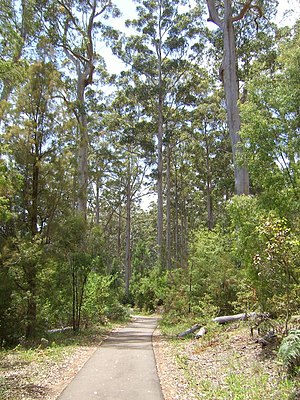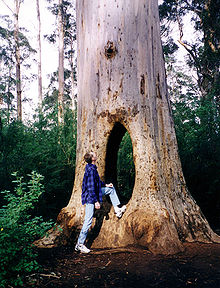Carribree
| Carribree | ||||||||||||
|---|---|---|---|---|---|---|---|---|---|---|---|---|

Forest with carribrees ( Eucalyptus diversicolor ) |
||||||||||||
| Systematics | ||||||||||||
|
||||||||||||
| Scientific name | ||||||||||||
| Eucalyptus diversicolor | ||||||||||||
| F. Garbage. |
The carribree ( Eucalyptus diversicolor ) is a species of the myrtle family (Myrtaceae). It occurs in the southwest of Western Australia and is called "Karri" there.
description
Appearance and leaf
Eucalyptus diversicolor grows as a tree that reaches heights of 10 to 60 meters, rarely up to 90 meters. The smooth bark peels in short ribbons or small polygonal patches, is white, gray, salmon-colored, orange or yellow and has glands. There are oil glands in the medulla.
The Karri tree has heterophyllia . The leaves on middle-aged specimens have petioles and the simple leaf blade is lanceolate to elliptical, sickle-shaped, entire and shiny green. The dull, two-colored (different on top and bottom) green leaves on adult specimens are relatively thick, broadly lanceolate, sickle-shaped and tapering towards the base with a pointed upper end. The lateral nerves are raised or barely noticeable. The cotyledons ( cotyledons ) are kidney-shaped.
Inflorescence, flower and fruit
The flowering time in Western Australia is in May, from September to December or from January to February. On the side of an inflorescence stem with a diameter of up to 3 mm in cross section, which is narrowly flattened or angular, stands a simple inflorescence that contains seven flowers.
The flower bud is club-shaped and not floured or frosted blue-green. The hermaphrodite flower is radially symmetrical with a double flower envelope . The sepals form a calyptra that falls off early. The calyptra is conical, as long and as wide as the flower cup. The flower cup (hypanthium) is smooth. The flowers are white or cream in color.
The fruit is spherical or egg-shaped and has a stem. The disc is dented. The fruit compartments are enclosed or at the level of the rim.
Occurrence
The natural range of the carribree is exclusively the extreme southwest of Western Australia . There Eucalyptus diversicolor occurs in the independent administrative districts of Albany , Augusta-Margaret River , Bridgetown-Greenbushes , Busselton , Capel , Cranbrook , Denmark , Manjimup , Nannup and Plantagenet in the South West and Great Southern regions . The carribree thrives on sandy loam soils on slopes.
Taxonomy
The first description of Eucalyptus diversicolor was made in 1863 by Ferdinand von Mueller in Fragmenta Phytographiae Australiae , Vol. 3 (22), S. 131. The type material has the inscription " In Australiae regionibus depressioribus quam maxime Austro-occidentalibus, ubi Blue Gum-tree vocatur. A. Oldfield ”. The specific epithet diversicolor is made up of the Latin words diversus for different and color for color and refers to the different colors of the top and bottom of the leaves.
Well-known single copies
- Diamond tree , a well-known carribree near Manjimup with a 52 meter high viewing platform.
- Gloucester Tree , a well-known 72 meter high carrib tree in Gloucester National Park with a 61 meter high observation deck.
Individual evidence
- ↑ a b Specimen search results: Eucalyptus diversicolor at Australia's Virtual Herbarium. Council of Heads of Australasian Herbaria . Retrieved January 23, 2013
- ↑ a b APNI = Australian Plant Name Index . Center for Plant Biodiversity Research. Australian Government. Retrieved January 23, 2013.
- ↑ a b c d Eucalyptus diversicolor in the Western Australian Flora . Retrieved January 23, 2013.
- ↑ a b c d e f g Eucalyptus diversicolor at EucaLink - A Web Guide to the Eucalypts . Retrieved January 23, 2013.
- ↑ Eucalyptus diversicolor at Tropicos.org. Missouri Botanical Garden, St. Louis, accessed January 23, 2013.

